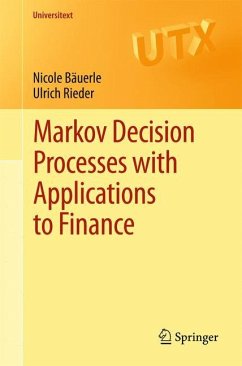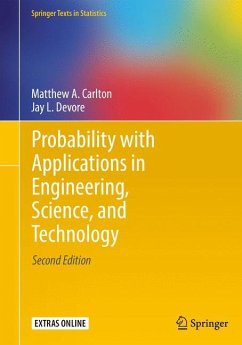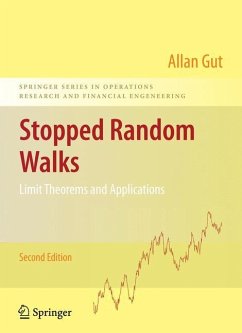
Probability and Random Processes with Applications to Signal Processing
International Edition
Versandkostenfrei!
Sofort lieferbar
63,99 €
inkl. MwSt.

PAYBACK Punkte
32 °P sammeln!
For courses in Probabil Features + Benefits
This text combines rigor and accessibility (i.e. less mathematical than the measure theory approach but more rigorous than formula and recipe manuals) with a strong self-teaching orientation.
A large number of worked-out examples, MATLAB codes, and special appendices that include a review of the kind of basic math needed for solving problems in probability as well as an introduction to measure theory and its relation to probability
Many self-test multiple-choice exams are now available for students at the book web site: http://www.pearsoninternationaleditions.com/stark . These exams were administered to senior undergraduate and graduate students at the Illinois Institute of Technology during the tenure of one of the authors who taught there from 1988-2006. The web site also includes an extensive set of small MATLAB programs that illustrate the concepts of probability.
Two new chapters on elementary statistics and their applications to real world problems. The first of these deals with parameter estimation and the second with hypothesis testing. The amount of added material on statistics will certainly satisfy the requirements of those curricula that offer courses that stress both probability and statistics in a one-semester course. The origin and applications of standard statistical tools such as the t-test, the Chi-square test, the F-test , order statistics, and percentiles are presented and discussed with detailed examples and end-of-chapter problems.
Preface
1 Introduction to Probability 1
1.1 Introduction: Why Study Probability? 1
1.2 The Different Kinds of Probability 2
Probability as Intuition 2
Probability as the Ratio of Favorable to Total Outcomes (Classical Theory) 3
Probability as a Measure of Frequency of Occurrence 4
Probability Based on an Axiomatic Theory 5
1.3 Misuses, Miscalculations, and Paradoxes in Probability 7
1.4 Sets, Fields, and Events 8
Examples of Sample Spaces 8
1.5 Axiomatic Definition of Probability 15
1.6 Joint, Conditional, and Total Probabilities; Independence 20
Compound Experiments 23
1.7 Bayes Theorem and Applications 35
1.8 Combinatorics 38
Occupancy Problems 42
Extensions and Applications 46
1.9 Bernoulli TrialsBinomial and Multinomial Probability Laws 48
Multinomial Probability Law 54
1.10 Asymptotic Behavior of the Binomial Law: The Poisson Law 57
1.11 Normal Approximation to the Binomial Law 63
Summary 65
Problems 66
References 77
2 Random Variables 79
2.1 Introduction 79
2.2 Definition of a Random Variable 80
2.3 Cumulative Distribution Function 83
Properties of FX(x) 84
Computation of FX(x) 85
2.4 Probability Density Function (pdf) 88
Four Other Common Density Functions 95
More Advanced Density Functions 97
2.5 Continuous, Discrete, and Mixed Random Variables 100
Some Common Discrete Random Variables 102
2.6 Conditional and Joint Distributions and Densities 107
Properties of Joint CDF FXY (x, y) 118
2.7 Failure Rates 137
Summary 141
Problems 141
References 149
Additional Reading 149
3 Functions of Random Variables 151
3.1 Introduction 151
Functions of a Random Variable (FRV): Several Views 154
3.2 Solving Problems of the Type Y = g(X) 155
General Formula of Determining the pdf of Y = g(X) 166
3.3 Solving Problems of the Type Z = g(X, Y ) 171
3.4 Solving Problems of the Type V = g(X, Y ), W = h(X, Y ) 193
Fundamental Problem 193
Obtaining fVW Directly from fXY 196
3.5 Additional Examples 200
Summary 205
Problems 206
References 214
Additional Reading 214
4 Expectation and Moments 215
4.1 Expected Value of a Random Variable 215
On the Validity of Equation 4.1-8 218
4.2 Conditional Expectations 232
Conditional Expectation as a Random Variable 239
4.3 Moments of Random Variables 242
Joint Moments 246
Properties of Uncorrelated Random Variables 248
Jointly Gaussian Random Variables 251
4.4 Chebyshev and Schwarz Inequalities 255
Markov Inequality 257
The Schwarz Inequality 258
4.5 Moment-Generating Functions 261
4.6 Chernoff Bound 264
4.7 Characteristic Functions 266
Joint Characteristic Functions 273
The Central Limit Theorem 276
4.8 Additional Examples 281
Summary 283
Problems 284
References 293
Additional Reading 294
5 Random Vectors 295
5.1 Joint Distribution and Densities 295
5.2 Multiple Transformation of Random Variables 299
5.3 Ordered Random Variables 302
Distribution of area random variables 305
5.4 Expectation Vectors and Covariance Matrices 311
5.5 Properties of Covariance Matrices 314
Whitening Transformation 318
5.6 The Multidimensional Gaussian (Normal) Law 319
5.7 Characteristic Functions of Random Vectors 328
Properties of CF of Random Vectors 330
The Characteristic Function of the Gaussian (Normal) Law 331
Summary 332
Problems 333
References 339
Additional Reading 339
6 Statistics: Part 1 Parameter Estimation 340
6.1 Introduction 340
Independent, Identically Distributed (i.i.d.) Observations 341
Estimation of Probabilities 343
6.2 Estimators 346
6.3 Estimation of the Mean 348
Properties of the Mean-Estimator Function (MEF) 349
Procedure for Getting a d-confidence Interval on the Mean of a Normal
Random Variable When sX Is Known 352
Confidence Interval for the Mean of a Normal Distribution When sX Is Not
Known 352
Procedure for Getting a d-Confidence Interval Based on n Observations on
the Mean of a Normal Random Variable when sX Is Not Known 355
Interpretation of the Confidence Interval 355
6.4 Estimation of the Variance and Covariance 355
Confidence Interval for the Variance of a Normal Random
variable 357
Estimating the Standard Deviation Directly 359
Estimating the covariance 360
6.5 Simultaneous Estimation of Mean and Variance 361
6.6 Estimation of Non-Gaussian Parameters from Large Samples 363
6.7 Maximum Likelihood Estimators 365
6.8 Ordering, more on Percentiles, Parametric Versus Nonparametric Statistics 369
The Median of a Population Versus Its Mean 371
Parametric versus Nonparametric Statistics 372
Confidence Interval on the Percentile 373
Confidence Interval for the Median When n Is Large 375
6.9 Estimation of Vector Means and Covariance Matrices 376
Estimation of µ 377
Estimation of the covariance K 378
6.10 Linear Estimation of Vector Parameters 380
Summary 384
Problems 384
References 388
Additional Reading 389
7 Statistics: Part 2 Hypothesis Testing 390
7.1 Bayesian Decision Theory 391
7.2 Likelihood Ratio Test 396
7.3 Composite Hypotheses 402
Generalized Likelihood Ratio Test (GLRT) 403
How Do We Test for the Equality of Means of Two Populations? 408
Testing for the Equality of Variances for Normal Populations:
The F-test 412
Testing Whether the Variance of a Normal Population Has a
Predetermined Value: 416
7.4 Goodness of Fit 417
7.5 Ordering, Percentiles, and Rank 423
How Ordering is Useful in Estimating Percentiles and the Median 425
Confidence Interval for the Median When n Is Large 428
Distribution-free Hypothesis Testing: Testing If Two Population are the
Same Using Runs 429
Ranking Test for Sameness of Two Populations 432
Summary 433
Problems 433
References 439
8 Random Sequences 441
8.1 Basic Concepts 442
Infinite-length Bernoulli Trials 447
Continuity of Probability Measure 452
Statistical Specification of a Random Sequence 454
8.2 Basic Principles of Discrete-Time Linear Systems 471
8.3 Random Sequences and Linear Systems 477
8.4 WSS Random Sequences 486
Power Spectral Density 489
Interpretation of the psd 490
Synthesis of Random Sequences and Discrete-Time Simulation 493
Decimation 496
Interpolation 497
8.5 Markov Random Sequences 500
ARMA Models 503
Markov Chains 504
8.6 Vector Random Sequences and State Equations 511
8.7 Convergence of Random Sequences 513
8.8 Laws of Large Numbers 521
Summary 526
Problems 526
References 541
9 Random Processes 543
9.1 Basic Definitions 544
9.2 Some Important Random Processes 548
Asynchronous Binary Signaling 548
Poisson Counting Process 550
Alternative Derivation of Poisson Process 555
Random Telegraph
This text combines rigor and accessibility (i.e. less mathematical than the measure theory approach but more rigorous than formula and recipe manuals) with a strong self-teaching orientation.
A large number of worked-out examples, MATLAB codes, and special appendices that include a review of the kind of basic math needed for solving problems in probability as well as an introduction to measure theory and its relation to probability
Many self-test multiple-choice exams are now available for students at the book web site: http://www.pearsoninternationaleditions.com/stark . These exams were administered to senior undergraduate and graduate students at the Illinois Institute of Technology during the tenure of one of the authors who taught there from 1988-2006. The web site also includes an extensive set of small MATLAB programs that illustrate the concepts of probability.
Two new chapters on elementary statistics and their applications to real world problems. The first of these deals with parameter estimation and the second with hypothesis testing. The amount of added material on statistics will certainly satisfy the requirements of those curricula that offer courses that stress both probability and statistics in a one-semester course. The origin and applications of standard statistical tools such as the t-test, the Chi-square test, the F-test , order statistics, and percentiles are presented and discussed with detailed examples and end-of-chapter problems.
Preface
1 Introduction to Probability 1
1.1 Introduction: Why Study Probability? 1
1.2 The Different Kinds of Probability 2
Probability as Intuition 2
Probability as the Ratio of Favorable to Total Outcomes (Classical Theory) 3
Probability as a Measure of Frequency of Occurrence 4
Probability Based on an Axiomatic Theory 5
1.3 Misuses, Miscalculations, and Paradoxes in Probability 7
1.4 Sets, Fields, and Events 8
Examples of Sample Spaces 8
1.5 Axiomatic Definition of Probability 15
1.6 Joint, Conditional, and Total Probabilities; Independence 20
Compound Experiments 23
1.7 Bayes Theorem and Applications 35
1.8 Combinatorics 38
Occupancy Problems 42
Extensions and Applications 46
1.9 Bernoulli TrialsBinomial and Multinomial Probability Laws 48
Multinomial Probability Law 54
1.10 Asymptotic Behavior of the Binomial Law: The Poisson Law 57
1.11 Normal Approximation to the Binomial Law 63
Summary 65
Problems 66
References 77
2 Random Variables 79
2.1 Introduction 79
2.2 Definition of a Random Variable 80
2.3 Cumulative Distribution Function 83
Properties of FX(x) 84
Computation of FX(x) 85
2.4 Probability Density Function (pdf) 88
Four Other Common Density Functions 95
More Advanced Density Functions 97
2.5 Continuous, Discrete, and Mixed Random Variables 100
Some Common Discrete Random Variables 102
2.6 Conditional and Joint Distributions and Densities 107
Properties of Joint CDF FXY (x, y) 118
2.7 Failure Rates 137
Summary 141
Problems 141
References 149
Additional Reading 149
3 Functions of Random Variables 151
3.1 Introduction 151
Functions of a Random Variable (FRV): Several Views 154
3.2 Solving Problems of the Type Y = g(X) 155
General Formula of Determining the pdf of Y = g(X) 166
3.3 Solving Problems of the Type Z = g(X, Y ) 171
3.4 Solving Problems of the Type V = g(X, Y ), W = h(X, Y ) 193
Fundamental Problem 193
Obtaining fVW Directly from fXY 196
3.5 Additional Examples 200
Summary 205
Problems 206
References 214
Additional Reading 214
4 Expectation and Moments 215
4.1 Expected Value of a Random Variable 215
On the Validity of Equation 4.1-8 218
4.2 Conditional Expectations 232
Conditional Expectation as a Random Variable 239
4.3 Moments of Random Variables 242
Joint Moments 246
Properties of Uncorrelated Random Variables 248
Jointly Gaussian Random Variables 251
4.4 Chebyshev and Schwarz Inequalities 255
Markov Inequality 257
The Schwarz Inequality 258
4.5 Moment-Generating Functions 261
4.6 Chernoff Bound 264
4.7 Characteristic Functions 266
Joint Characteristic Functions 273
The Central Limit Theorem 276
4.8 Additional Examples 281
Summary 283
Problems 284
References 293
Additional Reading 294
5 Random Vectors 295
5.1 Joint Distribution and Densities 295
5.2 Multiple Transformation of Random Variables 299
5.3 Ordered Random Variables 302
Distribution of area random variables 305
5.4 Expectation Vectors and Covariance Matrices 311
5.5 Properties of Covariance Matrices 314
Whitening Transformation 318
5.6 The Multidimensional Gaussian (Normal) Law 319
5.7 Characteristic Functions of Random Vectors 328
Properties of CF of Random Vectors 330
The Characteristic Function of the Gaussian (Normal) Law 331
Summary 332
Problems 333
References 339
Additional Reading 339
6 Statistics: Part 1 Parameter Estimation 340
6.1 Introduction 340
Independent, Identically Distributed (i.i.d.) Observations 341
Estimation of Probabilities 343
6.2 Estimators 346
6.3 Estimation of the Mean 348
Properties of the Mean-Estimator Function (MEF) 349
Procedure for Getting a d-confidence Interval on the Mean of a Normal
Random Variable When sX Is Known 352
Confidence Interval for the Mean of a Normal Distribution When sX Is Not
Known 352
Procedure for Getting a d-Confidence Interval Based on n Observations on
the Mean of a Normal Random Variable when sX Is Not Known 355
Interpretation of the Confidence Interval 355
6.4 Estimation of the Variance and Covariance 355
Confidence Interval for the Variance of a Normal Random
variable 357
Estimating the Standard Deviation Directly 359
Estimating the covariance 360
6.5 Simultaneous Estimation of Mean and Variance 361
6.6 Estimation of Non-Gaussian Parameters from Large Samples 363
6.7 Maximum Likelihood Estimators 365
6.8 Ordering, more on Percentiles, Parametric Versus Nonparametric Statistics 369
The Median of a Population Versus Its Mean 371
Parametric versus Nonparametric Statistics 372
Confidence Interval on the Percentile 373
Confidence Interval for the Median When n Is Large 375
6.9 Estimation of Vector Means and Covariance Matrices 376
Estimation of µ 377
Estimation of the covariance K 378
6.10 Linear Estimation of Vector Parameters 380
Summary 384
Problems 384
References 388
Additional Reading 389
7 Statistics: Part 2 Hypothesis Testing 390
7.1 Bayesian Decision Theory 391
7.2 Likelihood Ratio Test 396
7.3 Composite Hypotheses 402
Generalized Likelihood Ratio Test (GLRT) 403
How Do We Test for the Equality of Means of Two Populations? 408
Testing for the Equality of Variances for Normal Populations:
The F-test 412
Testing Whether the Variance of a Normal Population Has a
Predetermined Value: 416
7.4 Goodness of Fit 417
7.5 Ordering, Percentiles, and Rank 423
How Ordering is Useful in Estimating Percentiles and the Median 425
Confidence Interval for the Median When n Is Large 428
Distribution-free Hypothesis Testing: Testing If Two Population are the
Same Using Runs 429
Ranking Test for Sameness of Two Populations 432
Summary 433
Problems 433
References 439
8 Random Sequences 441
8.1 Basic Concepts 442
Infinite-length Bernoulli Trials 447
Continuity of Probability Measure 452
Statistical Specification of a Random Sequence 454
8.2 Basic Principles of Discrete-Time Linear Systems 471
8.3 Random Sequences and Linear Systems 477
8.4 WSS Random Sequences 486
Power Spectral Density 489
Interpretation of the psd 490
Synthesis of Random Sequences and Discrete-Time Simulation 493
Decimation 496
Interpolation 497
8.5 Markov Random Sequences 500
ARMA Models 503
Markov Chains 504
8.6 Vector Random Sequences and State Equations 511
8.7 Convergence of Random Sequences 513
8.8 Laws of Large Numbers 521
Summary 526
Problems 526
References 541
9 Random Processes 543
9.1 Basic Definitions 544
9.2 Some Important Random Processes 548
Asynchronous Binary Signaling 548
Poisson Counting Process 550
Alternative Derivation of Poisson Process 555
Random Telegraph
For courses in Probability and Random Processes. Probability, Statistics, and Random Processes for Engineers, 4e is a comprehensive treatment of probability and random processes that, more than any other available source, combines rigor with accessibility. Beginning with the fundamentals of probability theory and requiring only college-level calculus, the book develops all the tools needed to understand more advanced topics such as random sequences, continuous-time random processes, and statistical signal processing. The book progresses at a leisurely pace, never assuming more knowledge than contained in the material already covered. Rigor is established by developing all results from the basic axioms and carefully defining and discussing such advanced notions as stochastic convergence, stochastic integrals and resolution of stochastic processes.












